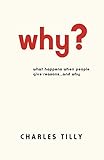Why? / Charles Tilly.
Material type: TextPublisher: Princeton, NJ : Princeton University Press, [2012]Copyright date: ©2006Edition: Course BookDescription: 1 online resource (224 p.) : 3 line illusContent type:
TextPublisher: Princeton, NJ : Princeton University Press, [2012]Copyright date: ©2006Edition: Course BookDescription: 1 online resource (224 p.) : 3 line illusContent type: - 9780691136486
- 9781400837786
- 302 302/.12
- HM1076
- online - DeGruyter
- Issued also in print.
| Item type | Current library | Call number | URL | Status | Notes | Barcode | |
|---|---|---|---|---|---|---|---|
 eBook
eBook
|
Biblioteca "Angelicum" Pont. Univ. S.Tommaso d'Aquino Nuvola online | online - DeGruyter (Browse shelf(Opens below)) | Online access | Not for loan (Accesso limitato) | Accesso per gli utenti autorizzati / Access for authorized users | (dgr)9781400837786 |
Frontmatter -- CONTENTS -- PREFACE -- WHY GIVE REASONS? -- CONVENTIONS -- STORIES -- CODES -- TECHNICAL ACCOUNTS -- RECONCILING REASONS -- REFERENCES -- INDEX
restricted access online access with authorization star
http://purl.org/coar/access_right/c_16ec
Why? is a book about the explanations we give and how we give them--a fascinating look at the way the reasons we offer every day are dictated by, and help constitute, social relationships. Written in an easy-to-read style by distinguished social historian Charles Tilly, the book explores the manner in which people claim, establish, negotiate, repair, rework, or terminate relations with others through the reasons they give. Tilly examines a number of different types of reason giving. For example, he shows how an air traffic controller would explain the near miss of two aircraft in several different ways, depending upon the intended audience: for an acquaintance at a cocktail party, he might shrug it off by saying "This happens all the time," or offer a chatty, colloquial rendition of what transpired; for a colleague at work, he would venture a longer, more technical explanation, and for a formal report for his division head he would provide an exhaustive, detailed account. Tilly demonstrates that reasons fall into four different categories: Convention: "I'm sorry I spilled my coffee; I'm such a klutz." Narratives: "My friend betrayed me because she was jealous of my sister." Technical cause-effect accounts: "A short circuit in the ignition system caused the engine rotors to fail." Codes or workplace jargon: "We can't turn over the records. We're bound by statute 369." Tilly illustrates his topic by showing how a variety of people gave reasons for the 9/11 attacks. He also demonstrates how those who work with one sort of reason frequently convert it into another sort. For example, a doctor might understand an illness using the technical language of biochemistry, but explain it to his patient, who knows nothing of biochemistry, by using conventions and stories. Replete with sparkling anecdotes about everyday social experiences (including the author's own), Why? makes the case for stories as one of the great human inventions.
Issued also in print.
Mode of access: Internet via World Wide Web.
In English.
Description based on online resource; title from PDF title page (publisher's Web site, viewed 29. Jul 2021)


